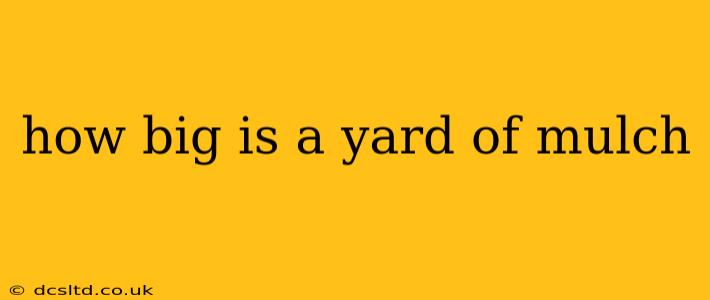Mulch is a crucial element for healthy landscaping, improving soil health, suppressing weeds, and enhancing the aesthetic appeal of your garden. But understanding how much mulch you need can be tricky. The question "How big is a yard of mulch?" is frequently asked, and the answer isn't as simple as it sounds. It's not about linear dimensions; it's about volume. Let's delve into this common landscaping query.
What Does a "Yard" of Mulch Actually Mean?
When you order a "yard" of mulch, you're ordering one cubic yard. This is a measure of volume, not area. Imagine a cube with sides measuring three feet (one yard) in length, width, and height. That's the volume of mulch you'd receive. It's a significant amount!
This means it's not about length or width; it's entirely about the volume of material. A cubic yard takes up considerable space.
How Much Area Will a Yard of Mulch Cover?
This is where things get more complex, as the coverage depends on the depth you want. The deeper the mulch layer, the less area a cubic yard will cover. Here's a breakdown:
- 1-inch depth: One cubic yard of mulch will typically cover approximately 324 square feet at a depth of one inch.
- 2-inch depth: For a two-inch layer, the coverage reduces to about 162 square feet.
- 3-inch depth: A three-inch layer will only cover approximately 108 square feet.
These are estimates, and the actual coverage can vary slightly based on the type of mulch (some are more densely packed than others) and how evenly it is spread.
What are the different types of mulch?
Different types of mulch have different properties that affect their coverage. Here are a few popular options:
- Wood chips: These are a common and affordable choice, varying in size and density.
- Shredded bark: Provides a finer texture and often decomposes a bit faster than wood chips.
- Straw: A lighter mulch that's good for moisture retention but less effective at weed suppression.
- Pea gravel: An inorganic option that offers excellent drainage and is durable.
How can I calculate how much mulch I need?
To accurately determine how much mulch you require, follow these steps:
- Measure the area: Determine the square footage of the area you want to cover. You can use a measuring tape or online calculators for irregular shapes.
- Choose your desired depth: Decide on the depth of mulch you want (1 inch, 2 inches, 3 inches, etc.).
- Calculate the cubic yards: Use an online mulch calculator or the formula: (Length x Width x Depth) / 27 (since there are 27 cubic feet in a cubic yard). Remember to convert your measurements to feet before calculating.
What if I have an oddly shaped area?
For irregularly shaped areas, break the area down into smaller, more manageable shapes (squares, rectangles, triangles) and calculate the area of each section. Add the individual areas together to get the total square footage. Then, proceed with the calculation as described above.
Is it better to overestimate or underestimate the amount of mulch needed?
It's always better to slightly overestimate than underestimate the amount of mulch you need. Having a little extra is better than running short and having to order more, potentially disrupting your landscaping project.
By understanding the volume involved and using appropriate calculation methods, you can ensure you get the right amount of mulch for your landscaping needs. Remember to consider the depth you desire for optimal results and the specific type of mulch you choose for its unique properties.
